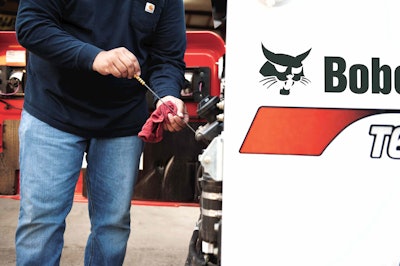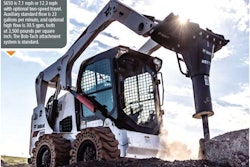 Photo: Bobcat
Photo: BobcatNew compact equipment enhancements make the machines more versatile and productive for professional landscape contractors. Landscape contractors should properly train their compact equipment operators on the following six maintenance items to avoid potential downtime and project overruns.
Tip No. 1: Review the manufacturer’s operation and maintenance manual.
First, compact equipment operators should familiarize themselves with the manufacturer’s operation and maintenance manual, which is typically stored in the machine’s cab for quick reference. It’s truly the Bible for properly operating and maintaining equipment, and keeping it in peak operating performance.
Tip No. 2: Inspect fluid levels and filters.
Fluids, including engine oil, coolant, hydraulic fluid, grease and drive motor lubricants should be checked regularly and need to be matched to the proper ambient temperatures as well as to the manufacturer’s recommendations. In addition, skid-steer and compact track loader fuel and air filters should be changed annually or sooner, depending on how many hours the machine is in use and the jobsite conditions. Proper fluid and filter increments can be found in the manufacturer’s operation and maintenance manual.
Tip No. 3: Check the battery.
One of the most important components to inspect is the machine’s battery. Make sure it is in good working order and, if needed, charge it to ensure it is ready to support the machine. Connections on the battery should also be clean to prevent hard starting and charging issues.
Tip No. 4: Examine tire pressure and track wear.
Check skid-steer loader tire pressure and, if needed, inflate the tires to the proper inflation pressure shown on the sidewall of the tires. This can save money by preventing downtime and help keep operators productive and profitable while on the jobsite.
Tip No. 5: Inspect the tracked undercarriage.
It is vital to keep compact equipment with tracked undercarriages clean to help minimize any material buildup that can contribute to wear. If the machines are being used in a colder climate, then mud, dirt and other debris may freeze and start to rub on the bolts, loosen the guiding and seize up the rollers. Routine and proper undercarriage cleaning helps to prevent unnecessary downtime and reduces potential wear later on.
Operators should complete a full undercarriage inspection for excessive or uneven wear, as well as look for damaged or missing components. During a routine machine inspection, check the tracks to see if any components look out of place or need repairs. In addition, inspect the rollers, idlers and drives for leakage.
Tip No. 6: Prepare attachments ahead of time.
Attachments require the same attention to maintenance as the machine itself. Visual checks of the hydraulic hoses, cylinders and guards on the attachments can help determine if damage or wear has occurred. Everything that engages with the ground, from bucket cutting edges to trencher teeth, for instance, should be looked at for wear and damage.
EDITOR’S NOTE: This article was provided by the Bobcat Company.











